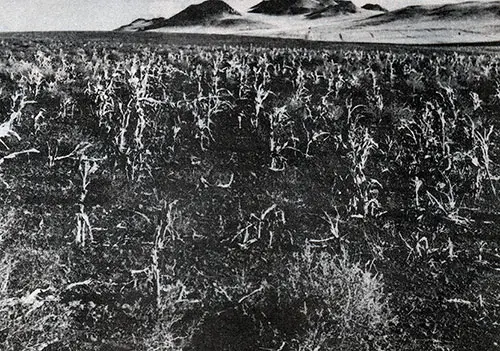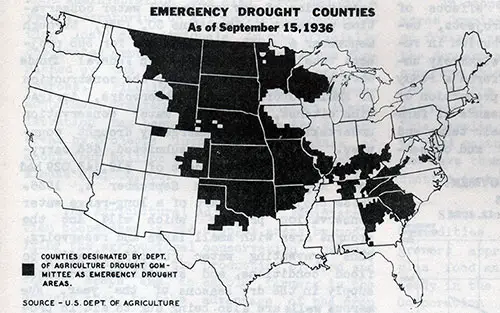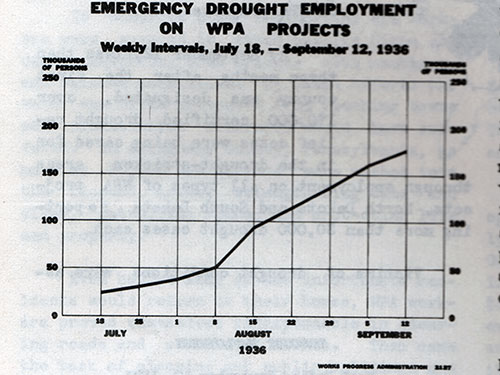Emergency Drought Relief - WPA

The flexibility of the WPA in meeting emergency conditions and cooperating with other agencies is further exemplified by the manner in which the Federal Government's forces were mobilized to meet the situation engendered by the drought of 1936.
Continuous heat and lack of rainfall were destroying crops at a constantly accelerating pace, and ravages of insect pests such as the grasshopper and the Mormon cricket contributed further to the general crop destruction.
Thousands of farmers in the Great Plains area were faced with ruin and starvation.
In response to this emergency the President formed the Inter-Departmental Drought Committee, composed of representatives of the Department of Agriculture, the Resettlement Administration, the Works Progress Administration, and other interested agencies.

This committee was charged with the function of coordinating and integrating the activities of the various Federal agencies operating in the drought area. The Department of Agriculture Drought Committee was established.
Under its immediate supervision the Department of Agriculture Drought Committee was given the function of officially designating emergency drought counties, based on reports and recommendations of directors of State agricultural services and of representatives of the Bureau of Agricultural Economics.
The determining factor in making such designations was the need for emergency drought assistance on the part of a large proportion of the farmers of a county. These designations served as a guide to all governmental agencies providing aid to farmers in regions affected by the drought.
By September 15, 1936, a total of 1,149 comities in 24 States had been officially designated as emergency drought counties.
The Department of Agriculture Drought Committee also completed arrangements with four large western railroads to reduce rates on the shipment of hay and other fodder into the drought areas.
The reduced rate on hay is two-thirds of the normal rate and the rate on coarse types of roughage one-half of the normal rate. These reductions have been authorized by the Interstate Commerce Commission.
The WPA and the Resettlement Administration cooperated in providing financial aid, through direct relief or work relief, to farmers in the emergency drought areas. Local relief authorities in conjunction with representatives of the WPA and the Resettlement Administration determined:
- The need of the persons affected by drought conditions, and
- Whether the needy person could best be aided by Resettlement Administration loans or grants, or by work provided on WPA projects.
Those persons too needy to be aided by Resettlement Administration loans or grants were certified, generally by local relief authorities, for WPA employment. Special procedures were devised to facilitate this certification and the subsequent employment of emergency drought relief cases on WPA projects.
On August 1, less than a month after the first emergency drought counties were officially designated, nearly 38,000 certified drought relief cases were employed and working on WPA projects.
By September 12, less than three months after the first county was designated, over 170,000 certified drought relief cases were being cared for in the drought-stricken areas through employment on all types of WPA projects, North Dakota and South Dakota reporting more than 30,000 drought oases each.
DROUGHT EMPLOYMENT
Week Ending September 12, 1936
(Subject to Revision)
Victims of drought conditions were assigned to projects which were already in operation or to new projects initiated with the two-fold purpose of providing additional employment in drought areas and of carrying on work that would alleviate the effects of drought.
Farm-to-market road projects, because of their widespread distribution in rural areas and the fact that relatively unskilled labor could be used, offered a ready means of employing the largest proportion of drought-stricken farmers. Thousands of farmers are being employed with their teams and tractors on farm-to-market roads and conservation projects.

Approximately 70 percent of the certified drought relief oases employed in Minnesota, North Dakota, South Dakota, and Wisconsin during the half month ending August 31, 1936, were working on farm-to-market roads.
About 15 percent were working on other highway, road, and street projects and 8 percent on conservation projects. This distribution of workers varied somewhat among the different States.
For example, in South Dakota as many as 12.5 percent of the certified and employed drought relief oases were working on conservation projects.
Special emphasis, both in the operation of previously approved projects and in the initiation of new projects, has been placed on water conservation work of all types.
WPA workers are busy building dams along streams, constructing reservoirs, digging community wells, and carrying out other water conservation projects which were planned for the drought area following surveys made in these States.
When forest fires broke out in Wyoming and other drought States, the WPA relief laborer played a significant part in helping to save both lives and property.
Besides prosecuting previously approved projects the WPA program was expanded by the institution of new and useful water conservation projects.
From June 30, 1936, through September 4, 1936, applications for 585 projects totaling $25,280,250 in Federal funds were received by the WPA for the construction of small concrete dams, reservoirs, irrigation ditches, and other water conservation undertakings in the emergency drought counties.
Of the projects submitted, 463 carrying a total Federal cost of $19,143,029 had been approved through September 4, 1936. These projects are part of a long-range water conservation program which will dot the drought area with small lakes and reservoirs, thus preventing water run-offs leading to flood conditions, and stabilizing the water supply in the dry seasons of the year.
Numerous wells are also being dug to aid in providing an adequate supply. One hundred and five water conservation projects have been submitted from North Dakota and have been approved by the President since June 30, 1936, and 77 such projects have been approved for operation in Oklahoma.
In addition to these water conservation projects, 788 other applications have been received for projects suitable to the employment of farm labor in the drought counties.
The cost in Federal funds for these projects is $30,106,146. Approval by the President has been given to 419 of these applications, having a Federal cost of $13,899,501.
The fact that approval has been given to less than 50 percent of these applications as compared with approval of more than 75 percent of the water conservation projects is indicative of the emphasis placed on water conservation in the drought area.
The first consideration of this program, as in other emergency activities, has been the preservation of health and the protection of life and property. Food and clothing have been furnished through the surplus commodity projects of the WPA. Water has been supplied by wells dug under WPA auspices and sometimes has even been carried by truck into the stricken areas.
Through September 15 the Resettlement Administration had designated a total of $14,296,436 for making loans and grants to farmers who could best be aided in this manner.
By this date 8,742 loans totaling $1,638,660 had bean made for livestock, feed or for quick-maturing forage crop seeds, and 96,216 grants for subsistence needs amounting to $1,406,924 had been arranged.
The Resettlement Administration has also provided for a year's moratorium on all previous rehabilitation loans to individuals in the officially designated drought counties, on evidence furnished by the borrower of a lack of cash resources.
Finally, the long-range land-use adjustment program of the Resettlement Administration has been amplified in the drought areas by projects involving the purchase of about four million acres of land at a cost of almost $14,000,000.
The Agricultural Adjustment Administration cooperated in the drought areas by modifying the agricultural conservation program so as to increase the production of food and forage crops and to enable farmers in the drought area to take advantage of the crop income insurance features of the agricultural conservation program.
This Administration was allotted $5,000,000 for the purchase of cattle at market prices. Purchases were restricted to cattle originating in the drought area. The cattle were to be processed by private packing concerns under contract, and the meat was to be turned over to the Federal Surplus Commodities Corporation for distribution to families on relief rolls.
In contrast to the 1934 drought program special benefit payments were not made to livestock growers. This year's program was designed to prevent demoralization of cattle prices by the forced liquidation of livestock holdings in the emergency drought area.
In cooperation with the Interstate Commerce Commission the AAA secured reductions on freight rates for livestock shipped from the drought areas to good pastures. On an outgoing shipment the rate was set at 85 percent of the normal rate and on the return shipment at 15 percent of the normal rate.
This permits cattlemen to ship their cattle to good pastures during the drought emergency and have them returned with a 50 percent reduction in transportation costs.
Since early June the Federal Surplus Commodities Corporation has purchased from growers approximately 1,600 carloads of surplus food and feed for distribution to the needy in the drought-stricken States.
The Corporation also underwrote and supervised the purchase of 7 to 9 million bushels of small grains for seed purposes. This was accomplished with an advance to the Farmers National Grain Corporation of $10,000,000 by the Farm Credit Administration.
A number of other Federal agencies operating projects under the Works Program in the emergency drought areas expanded their programs in these regions in order to employ certified drought cases.
The Federal agencies employing the greatest number of drought cases include the Soil Conservation Service, the Forest Service, and the Bureau of Public Roads.
